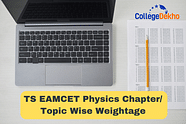
TG EAMCET 2025 Chemistry Chapter-Wise Questions with Solutions
: When it comes to scoring good marks in the TG EAMCET Chemistry section, one of the most important study tips suggested by experts and toppers is practising TG EAMCET 2025 Chemistry chapter-wise questions with solutions. Attempting chapter-wise TG EAMCET 2025 Chemistry questions with solutions can help the students identify the key topics and sub topics from where the maximum number of questions are asked. While solving TG EAMCET Chemistry question papers, students may find that some select questions are often repeated year-on-year. It is important to focus on important topics such as p-Block Elements, including Groups 14, 15, and 17, and d-Block elements, with particular attention to Groups 13, 17, and 18. Understanding Organic Chemistry principles and techniques is also essential, along with studying Organic Compounds Containing Carbon, Hydrogen, and Oxygen from the
TS EAMCET 2025 Chemistry syllabus PDF
. Topics like Electrochemistry and the Classification of Elements provide a strong foundation in chemical reactions and periodic properties. Additionally, Atomic Structure, Chemical Bonding, and Solutions is also vital, as these form the core of many questions in the exam. Practicing questions from these areas will help students solidify their preparation for the test.
Also Check -
TG EAMCET 2025: Application Form, Exam Dates, Eligibility, Pattern, Preparation
NCERT Chemistry textbooks for classes 11 and 12 are highly recommended, along with other reference books for varied question practice. The TG EAMCET exam 2025 will be conducted online for a duration of 3 hours and a total of 160 objective-type questions, including 40 questions from Chemistry. Each question will carry one mark. Preparing for the TG EAMCET 2025 Chemistry exam can feel overwhelming, but breaking it down chapter by chapter makes it easier. Let us do some practise based on TG EAMCET 2025 Chemistry chapter-wise questions with solutions.
Also Check -
TG EAMCET 2025 Exam Date: Application Form, Hall Ticket, Answer Key, Result Date
Quick Links:
TG EAMCET 2025 Chemistry Chapter Wise Questions with Solutions
Below are some important TG EAMCET 2025 Chemistry questions with solutions to help students practice effectively. These questions are designed to cover key topics and provide a clear understanding of the concepts. By working through these examples, students can learn the correct approaches to solve different types of problems. The correct answers have been highlighted in red.
Chemical Bonding and Molecular Structure
Q 1. The main axis of the molecule is along the Z-axis. The orbitals Px and Py overlap to form:a) No bond is formed
b) δ-molecular orbital
c) σ-molecular orbital
d) π-molecular orbital
Solution:
Since Px and Py orbitals are oriented perpendicular to each other and to the Z-axis, they do not overlap effectively along the main axis (Z-axis) to form a bond.
a) 1 and diamagnetic
b) 0 and diamagnetic
c) 1 and paramagnetic
d) 0 and paramagnetic
Solution:
For the diatomic molecule B2, if Hund’s rule is violated (meaning electrons do not occupy degenerate orbitals singly before pairing), the bond order would be 1, and the molecule would be paramagnetic due to the presence of unpaired electrons in the molecular orbitals.
a) H2O
b) Salicylaldehyde
c) NH3
d) Benzophenone
Solution:
In salicylaldehyde, intramolecular hydrogen bonding forms
when the hydrogen atom from the hydroxy group bonds with the oxygen atom from the aldehyde group
. This results in a double-ring structure
.
Quick Links:
Solutions
Q 1. Calculate the osmotic pressure in pascals exerted by a solution prepared by dissolving 1.0 g of a polymer with a molar mass of 185,000 in 450 mL of water at 37°C.a) 31 Pa
b) 27 Pa
c) 23 Pa
d) 19 Pa
Q 2. If the density of CH3OH(methanol) is 0.793 kg/L, what is the volume of methanol needed to make 2.5 L of a 0.25 M solution?a) 20.2 mL
b) 50.4 mL
c) 25.2 mL
d) 10.0 mL
Q 3. The osmotic pressure of a solution can be increased by:a) Diluting the solution
b) Increasing the volume of the vessel
c) Decreasing the temperature of the solution
d) Increasing the temperature of the solution
Electrochemistry
Q 1. The EMF of a galvanic cell consisting of two hydrogen electrodes is 0.17 V. If the concentration of [H+] at one electrode is 10−3 M, what is the pH at the other electrode?a) 5.88
b) 4.88
c) 2.08
d) 3.08
Solution:
pH=−log[H+]≈−log(5.49×10−4)≈3.08
a) Oxidation of chloride
b) Reduction of sodium ions
c) Reduction of chlorine
d) Oxidation of sodium atoms
Solution:
In the electrolysis of fused sodium chloride (NaCl), sodium ions (Na+) migrate to the cathode, where they are reduced to sodium metal. Chloride ions (Cl−) migrate to the anode, where they are oxidized to chlorine gas (Cl2). This corresponds to the oxidation of chloride ions.
a) Dry cell
b) Galvanic cell
c) Mercury cell
d) Lithium cell
p- Block Elements
Q 1. Consider the compounds, BCl3, and CCl4. How will they behave with water? Justify.a) They will react vigorously with water
b) They will slowly react with water
c) They will partially react with water
d) They will show no reaction with water
Solution:
In BCl3, there are only six electrons in the valence shell of B atom. Thus, the octet is incomplete and it can accept a pair of electrons from water and hence BCl3 undergoes hydrolysis. Whereas, in CCl4, the C atom has 8 electrons and its octet is complete. That’s why it has no tendency to react with water.
a) Yes, because it donates protons in solution
b) No, because it accepts electron pairs from other molecules
c) Yes, because it dissociates to release H+ ions in water
d) No, because it reacts with water to form hydroxide ions directly
Solution:
Boric Acid is not a protic acid, because it accepts electron pairs from other molecules. It is a Lewis Acid.
a) Carbon
b) Nitrogen
c) Phosphorus
d) Sulfur
Explanation:
In the p-block elements, nitrogen exhibits the highest oxidation state in its compounds. For example, in nitrogen trifluoride (NF₃), nitrogen has an oxidation state of +3, and in nitrogen pentafluoride (NF₅), it reaches +5. This is higher than the maximum oxidation states exhibited by carbon (+4), phosphorus (+5), and sulfur (+6) in their respective compounds.
d- Block Elements
Q 1. Which of the following d-block elements shows the maximum number of oxidation states?
a) Chromium
b) Manganese
c) Iron
d) Zinc
Explanation:
Manganese exhibits a wide range of oxidation states, from +2 to +7, which is the maximum number among the d-block elements listed.
Q 2. Which of the following is true about the colour of transition metal complexes?
a) All transition metal complexes are colourless
b) Colour of transition metal complexes is due to d-d transitions
c) The colour of transition metal complexes is due to f-f transitions
d) The colour of transition metal complexes is due to charge transfer transitions
Explanation:
The colour of transition metal complexes is primarily due to the d-d electronic transitions, where electrons move between different d-orbitals split by the ligand field.
Q 3. Which of the following statements about the stability of oxidation states of transition metals is correct?
a) The stability of higher oxidation states increases with increasing atomic number
b) The stability of lower oxidation states is generally observed in lighter transition metals
c) Higher oxidation states are more stable in aqueous solutions
d) All transition metals exhibit only one stable oxidation state
Explanation:
In transition metals, the stability of lower oxidation states is often observed in lighter transition metals, while the heavier ones tend to exhibit higher oxidation states.
Also Check -
TG EAMCET 2025 Syllabus: Subject-Wise Syllabus Topics
Quick Links:
| TS EAMCET 2025 Exam Date | TS EAMCET 2025 Eligibility Criteria |
|---|---|
| TS EAMCET 2025 Registration | TG EAMCET 2025 Admit Card |
| TS EAMCET 2025 Exam Centres | - |
TG EAMCET 2025 Chemistry Questions with Solutions PDF
To get easy access to the Chemistry practice papers, students can download the TG EAMCET 2025 Chemistry chapter-wise questions with solutions PDF from this link:-
| TG EAMCET 2025 Chemistry Questions with Solutions PDF Download Link |
|---|
Related Articles
| TG EAMCET 2025 Physics Chapter-Wise Questions with Solutions |
|---|
We hope this article on TG EAMCET 2025 Chemistry Chapter-Wise Questions with Solutions will be helpful to all aspirants. Stay tuned to CollegeDekho for more updates!
Are you feeling lost and unsure about what career path to take after completing 12th standard?
Say goodbye to confusion and hello to a bright future!

Was this article helpful?





















Similar Articles
TS EAMCET 2026 Physics Chapter/ Topic Wise Weightage & Important Topics
KCET Physics All Formulas PDF
Is GUJCET only for Engineering?
KCET 2026 OMR Sheet – Sample (PDF Download), Instructions, Carbon Copy
GUJCET 2026 Application Form Correction: Check Process, Dates, Here
KCET Login 2026 - User ID, Application Number, Password, Steps to Retrieve